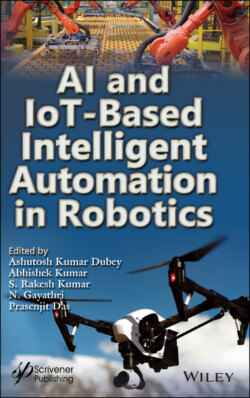Читать книгу AI and IoT-Based Intelligent Automation in Robotics - Группа авторов - Страница 27
2.3 Some General Terms
ОглавлениеArtificial Intelligence: Refers to making machines capable of mimicking human behavior and intelligence in a way to act and think like humans. And it is called artificial because the intelligence has been given to machines by means of some programming which is dissimilar to the natural intelligence exhibited by humans. The term “artificial intelligence” (AI) was first coined in 1856 by John McCarthy. AI is one of the disruptive technologies with powerful features and can be used in a wide variety of applications; for example, AI can be used to play games, monitor the health of patients and used as a traffic controller system. In the education sector it can act as an independent and effective tutor; apart from that it can be used to predict diseases and weather, etc. The list is countless [7] as it finds endless possibilities of applications due to its advanced characteristics and tools.The Venn diagram of AI in Figure 2.1 below shows that it is the superset of machine learning (ML) and deep learning (DL).
Machine Learning: Describes the learning behavior of machines by means of data fed to it. Based upon learning the machine makes predictions based on statistical inference and finding a pattern in data by using some advanced mathematical models [8]. It is the branch of artificial intelligence that works in its backend and defines various algorithmic procedures to be followed to make the machine intelligent so as to make accurate predictions [9]. Based on the learning behavior and the type of data, it is divided into four types:Figure 2.1 Venn diagram of AI, ML and DL.− Supervised learning− Unsupervised learning− Semi-supervised learning− Reinforcement learning
Agent: Refers to something that perceives the environment through sensors and performs action via actuators based on some predefined rules for which the agent is trained. Just like in humans, there are five sense (i.e., sight, sound, smell, taste, and touch), and based on the information of our senses we perform actions through our limbs, etc. A simple diagrammatic representation of an agent is shown in Figure 2.2 below.The agents act as a backbone for AI techniques that govern how they are working and what sorts of applications they are dealing with. Based on utility there are different types of agents [10]:− Simple reflex agent− Model-based agent− Goal-based agent− Utility-based agentFigure 2.2 Representation of an agent.
Internet of Things: Refers to the interconnection of the things that we use in our daily lives with the internet. The basic idea of the IoT [11] is to connect all the devices through the internet via short-range wireless devices, such as Zigbee, Bluetooth, RFID, and various sorts of sensors and devices [12], by which they can communicate with each other and share the sensor data among the peer devices in order to facilitate the end-user/client via cloud services. It is one of the most demanding technologies in any industry and from 2019 to 2025 it is expected to grow by 33.81% [13]. The basic architecture of the IoT is shown in Figure 2.3 below.
Robots: Programmable machines capable of performing complex tasks in intense and rigorous environments. They are designed as in Figure 2.4 to automate any human tasks with the controllers built-in or outside based on the requirements. Robots are now being used in many places [14] to perform dangerous or repetitive tasks to safeguard humans, and are being used especially in industry in painting jobs, warehouses, assembly lines, etc. So, basically, they are automating the environment in order to reduce human efforts. And now robots have become an essential commodity of many sectors; for example, they find application in healthcare [15], education, research and development, and are used in architecture, as waiters in restaurants, and almost all the sectors of our economy. With the increase in research and innovation, more and more intelligent systems are being prepared that are forming the foundation of modern society and helping in reshaping the future.
Figure 2.3 Architecture of the Internet of Things.
Figure 2.4 Basic robot architecture.
